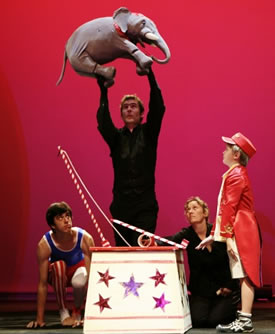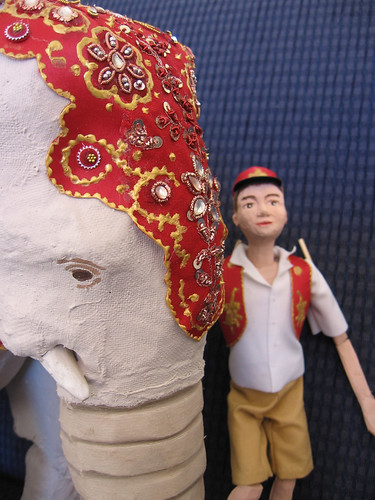A month or two ago I started an experiment to see if could keep up with the news just by following links from my Twitter updates, instead of scrolling through the sea of crap on the front pages of online papers like the Age, SMH and others. I’m happy to say it’s been an easy transition, and today I took it a step further by changing my bookmarks for those two newspapers to their opinion sections.
media
The Promise
Remember the little elephant and boy puppets I was working on last year? Here are some pictures of how they turned out. They were for the Flying Fruitfly Circus production The Promise, which premiered at the Sydney Festival about a month ago. The build for the show was quite big, and largely undertaken by Tim Denton and Annie Forbes in Melbourne, but I was asked to make these little ones and a life-size elephant trunk (more of the trunk soon in another post). The designer was Richard Jeziorny, whom I really like working with.
It’s part of the business that directors sometimes need to alter significantly or completely cut scenes and props, and in this case the elephant was altered or remade in Melbourne so that it could have more head movement than the original design. I was given the opportunity to do it, but couldn’t take it on at the time. It looks from this picture as if it was covered and the head possibly remade completely.

The production received great reviews such as this at the Australian Stage Online. I’d like to see it one day if they tour up this way.
Previously:
A little heffalump
Playing
Studio pics
Nearly done
Funny

Laura tells how six million were deprived at the Jane Austen and Comedy Conference in Melbourne! Germiane Greer gave the introductory lecture.
Pushing the envelope
Amy writes about how Coke is at least making the right noises about respecting users wishes in relation to Facebook Beacon. Dave thinks Facebook was deliberately testing the waters. Of course leaking to test or dilute reaction has been a political tool for eons.
I’ve heard Roger Law, one of the creators of the famed satirical 1980’s TV puppet show Spitting Image talk about pushing the envelope of what is acceptable socially. He said that at that time in the UK, it was much more difficult to publish questionable material in the print media, whereas censorship was less strict and it was easier to get away with more on TV. He wondered if a reason might be that TV was taken less seriously. He added that if your show was successful, you could then be more audacious next time, even from week to week. I thought that was really interesting, and I’ve watched it happen since. The Chaser is an example; you couldn’t imagine them getting away with things like the APEC security breach or the Eulogy Song if they were new kids on the block. Think, too, how the excuser of the disastrous Lindsay fake political flyer, tried to palm it off as a ‘Chaser-style prank’ without understanding that tradition.
I guess the web is also somewhat differentiated from the older media with regard to pushing the boundaries of conventional feelings about privacy and social mores, and advertising within it is pushing the envelope in every which way it can, seeking new niches. I don’t want anything to do with Facebook’s advertising, and it is one of a number of reasons I remain somewhat aloof from FB. But I expect that what seems audacious today, the type of targeted advertising within social networks that Facebook (even if it has backtracked to an opt-in basis) has introduced, will become just like the furniture tomorrow, for better or worse. Chris Matyszczyk challengingly points out that this sits with a tradition, too.
Branding Grattan
I’m kind of amused at The Age’s attempts to promote their op-ed writers, in particular their political editor and bureau chief, Michelle Grattan. For one thing, she is such a good journalist, and already so highly regarded, that it seems silly. For another, it looks like they can’t quite get it right. The front page pointers for each new article, now with profile pics, are fine; every paper is doing it. But then ten days ago they announced the blog Grattan. I was pleased with the idea of being able subscribe and follow in my feed reader, but so far it turns out it isn’t being used, and most of her articles, understandably, (especially during the election campaign) are leader stories on the front page, and not copied to the blog. The thing that tickled me most, though, was the foray into video commentary, where Grattan gave her usual great analysis, talking directly to the anchor, but without looking at the camera. It looks to me as if The Age is desperate to make her into a brand that can be monetised, and she – and probably we – are really much more interested in what she is actually saying, because its not fluff, it’s worth hearing.
There was a confirmation of this in a more general sense in the ABC Media Report’s radio discussion on blogging the other day. The General Manager of Media at Fairfax Digital, Pippa Leary, said that commercial considerations meant that the blogs that you see coming onto the Sydney Morning Herald and the Age websites are usually those deemed likely to either going to bring in a lot of traffic or a lot of sponsors. They have discovered that blogs not only bring in interaction between journalists and their audience, but also new niche audiences which attract new sponsors:
So think about something like ‘Sam and the City’ — now it’s called ‘Ask Sam’ — it’s the second most popular blog on our site. If you think about what we have in The Sydney Morning Herald print edition, we don’t attract 15- to 18-year-old girls like we attract through ‘Sam and the City’, and for a lot of people that’s a lot of angst, but for us as the commercial division, we now can put Lancome, L’Oreal, a whole lot of different FMCG advertisers we would never have been able to attract before, so we look at blogs as a really great opportunity.
Out of curiosity, I subscribed to Grattan and Ask Sam in Bloglines, and they have 1 and 10 subscribers respectively. The other one I have been subscribed to for a while is Chew on This, which has 8. I interpret that to mean that the general reader doesn’t distinguish between much between blogs and articles, except for being able to comment.
Anything for an angle
I haven’t caught up with the whole conversation yet, but today I’ve been reading Danah Boyd‘s posts on Facebook and controlling ones public appearance. I’m pretty wary of Facebook for a variety of reasons, but retain a curiosity about the impact it is having and might yet have.
But by coincidence I then turned to today’s Canberra Times, which, bless its cotton socks, has a front page story about the Australian soldier who was killed in Afghanistan, using a photograph and information from his private Facebook profile… I’d be interested to know how they got into his account – I guess they wooed one of his friends, maybe persuaded them it was respectful to show the public a glimpse of his personal side? I really dislike the way the media handles personal tragedy these days.
What a difference an interface makes
Recent revisions of news websites have changed my news reading habits. It used to be that my first ports of call were the Fairfax papers – The Melbourne Age and the Sydney Morning Herald . I would scan the ABC for the most up-to-date and factual reporting. Then a quick look at The Australian for a reality check on the the other side of politics, but mostly to check on Bill Leak’s daily cartoon.
ABC News is my now my first option. It’s not only that their page and usability is more attractive, its also that the Fairfax papers have become less attractive and harder to use. Their celebrity junk aspect seems even more prominent with the big strip of photos across the bottom of fold, the dark background that makes the main photo caption readable takes an annoying time to load, and the ads and changing video links are really distracting. I particularly despise the ads that zoom out and take over your screen. That’s when I walk away – you would think advertisers would know this by now! And the opinion and world pages are buried way down the page. The Australian website is improved, but its font is too small, and it also inflicts those zoom out ads on its readers, too.
The upshot: ABC is the main game. Fairfax for opinion pieces only. Bill Leak’s cartoon.
Go the ABC!
The Australian Broadcasting Commission has again shown it’s willingness to adopt and make the most of new media with it’s shiny new ABC News site. It’s really cool – personalized tagging, great embedded video and audio, and an attractive interface, among other features.
What a beat up!
The Fairfax papers are running a curious 3-page story today saying Justice Michael Kirby ‘has been vilified and defamed by fraudsters who have stolen his identity to post offensive material on the popular internet site MySpace,” and implying it is a first case scenario. Good grief, what a beat up!
Is this just lazy or out-of-touch MSM journalism? A very quick perusal of My Space gives you hosts of fake identity pages, and sometimes more than one for people with high profiles. There are numerous bogus identity pages for many of Australia’s political players, and if you care to look further afield, identities such as the Pope, the Queen, and Rupert Murdock himself. Most of them are crude and lame attempts at satire. The jabs on the fake Kirby page are not much different to ones on the fakes for Amanda Vanstone, or Alexander Downer, for example. It sounds as if MySpace will take the Kirby page down if approached. The comparison to real cases of stolen identity at the end of the article is nonsense.
If it’s not laziness, why highlight Kirby? Is it another instance of smearing Kirby (while appearing to do otherwise)?
The article also says ‘The case… underlines the flimsy or fraudulent nature of much of the internet’s so-called “citizen journalism”.’ The MySpace pages are attempted spoofs within a social networking site rather than citizen journalism. While there is plenty of lively discussion about issues surrounding citizen journalism, this appears to be an uninformed and broadsweeping (or flimsy and fraudulent?) smear on new media.
My feeling is that the only thing to be trusted here is that Michael Kirby will deal with the issue with his usual dignity, intelligence, and allegiance to free speech.





